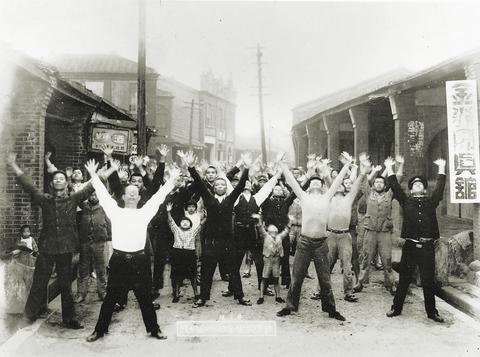For a brief, yet interesting photographic look at Taiwan of yesteryear, the National Museum of History (
Entitled A Retrospective of One Hundred Years' of Taiwan Photography (
Focusing predominantly on people rather than places, the works paint an interesting picture of not only the development of photography in Taiwan but also of its peoples. The exhibition begins with some of the earliest photographs taken in Taiwan by foreign photographers.

PHOTO COURTESY OF NATIONAL MUSEUM OF HISTORY
Many of these early works, such as those taken by Japanese national Torii Ryuzo (
Ryuzo took some stunning shots of Atayal and Ami men, women and children, at a time when very few foreigners had ever seen such peoples, often dressed in their battle gear. His subjects are generally posing, fully aware a camera is being pointed at them.
Examples of works by Taiwan's "first" photographer, Lin Tsao (

Other works of note include those by Wu Jin-miao (
Some shots of the time are less funny, however. Deng Nan-guang (
The shot, taken in 1940, shows a group of soldiers walking passed a crowd of civilians, all of whom are bowing in respect, or possibly dread.
Sadly, like many other exhibitions at the museum, English language material is minimal and the show gives viewers an all to brief glimpse of the works of the nation's pioneering photographers.
For those who wish to learn more, and who posses moderate Chinese language capabilities, then in addition to the exhibition, a special two-day seminar featuring panel discussions and lectures apropos the history and development of photography in Taiwan will take place on Saturday, Nov. 8 and Sunday, Nov. 9.
For further information about the seminar, call (02) 2370 6031 or email janet@moe.nmh.gov.tw.

In the March 9 edition of the Taipei Times a piece by Ninon Godefroy ran with the headine “The quiet, gentle rhythm of Taiwan.” It started with the line “Taiwan is a small, humble place. There is no Eiffel Tower, no pyramids — no singular attraction that draws the world’s attention.” I laughed out loud at that. This was out of no disrespect for the author or the piece, which made some interesting analogies and good points about how both Din Tai Fung’s and Taiwan Semiconductor Manufacturing Co’s (TSMC, 台積電) meticulous attention to detail and quality are not quite up to

April 21 to April 27 Hsieh Er’s (謝娥) political fortunes were rising fast after she got out of jail and joined the Chinese Nationalist Party (KMT) in December 1945. Not only did she hold key positions in various committees, she was elected the only woman on the Taipei City Council and headed to Nanjing in 1946 as the sole Taiwanese female representative to the National Constituent Assembly. With the support of first lady Soong May-ling (宋美齡), she started the Taipei Women’s Association and Taiwan Provincial Women’s Association, where she

It is one of the more remarkable facts of Taiwan history that it was never occupied or claimed by any of the numerous kingdoms of southern China — Han or otherwise — that lay just across the water from it. None of their brilliant ministers ever discovered that Taiwan was a “core interest” of the state whose annexation was “inevitable.” As Paul Kua notes in an excellent monograph laying out how the Portuguese gave Taiwan the name “Formosa,” the first Europeans to express an interest in occupying Taiwan were the Spanish. Tonio Andrade in his seminal work, How Taiwan Became Chinese,

Mongolian influencer Anudari Daarya looks effortlessly glamorous and carefree in her social media posts — but the classically trained pianist’s road to acceptance as a transgender artist has been anything but easy. She is one of a growing number of Mongolian LGBTQ youth challenging stereotypes and fighting for acceptance through media representation in the socially conservative country. LGBTQ Mongolians often hide their identities from their employers and colleagues for fear of discrimination, with a survey by the non-profit LGBT Centre Mongolia showing that only 20 percent of people felt comfortable coming out at work. Daarya, 25, said she has faced discrimination since she